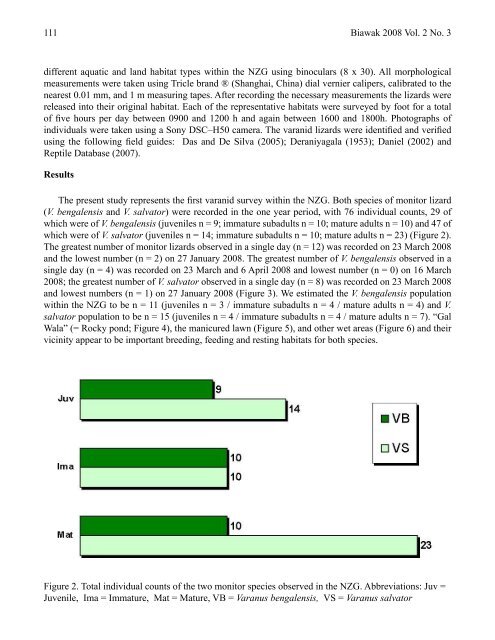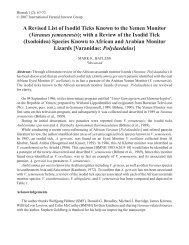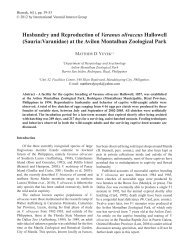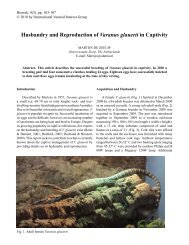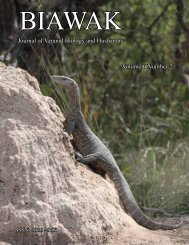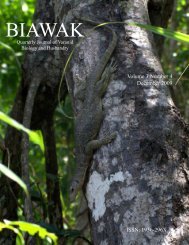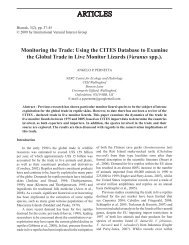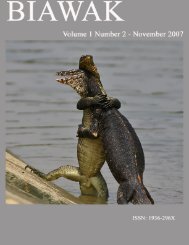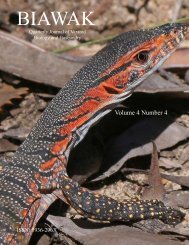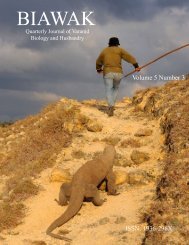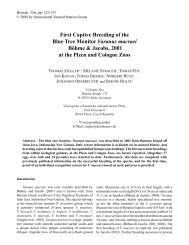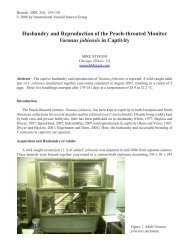Volume 2 Number 3 - International Varanid Interest Group
Volume 2 Number 3 - International Varanid Interest Group
Volume 2 Number 3 - International Varanid Interest Group
Create successful ePaper yourself
Turn your PDF publications into a flip-book with our unique Google optimized e-Paper software.
111 Biawak 2008 Vol. 2 No. 3different aquatic and land habitat types within the NZG using binoculars (8 x 30). All morphologicalmeasurements were taken using Tricle brand ® (Shanghai, China) dial vernier calipers, calibrated to thenearest 0.01 mm, and 1 m measuring tapes. After recording the necessary measurements the lizards werereleased into their original habitat. Each of the representative habitats were surveyed by foot for a totalof five hours per day between 0900 and 1200 h and again between 1600 and 1800h. Photographs ofindividuals were taken using a Sony DSC–H50 camera. The varanid lizards were identified and verifiedusing the following field guides: Das and De Silva (2005); Deraniyagala (1953); Daniel (2002) andReptile Database (2007).ResultsThe present study represents the first varanid survey within the NZG. Both species of monitor lizard(V. bengalensis and V. salvator) were recorded in the one year period, with 76 individual counts, 29 ofwhich were of V. bengalensis (juveniles n = 9; immature subadults n = 10; mature adults n = 10) and 47 ofwhich were of V. salvator (juveniles n = 14; immature subadults n = 10; mature adults n = 23) (Figure 2).The greatest number of monitor lizards observed in a single day (n = 12) was recorded on 23 March 2008and the lowest number (n = 2) on 27 January 2008. The greatest number of V. bengalensis observed in asingle day (n = 4) was recorded on 23 March and 6 April 2008 and lowest number (n = 0) on 16 March2008; the greatest number of V. salvator observed in a single day (n = 8) was recorded on 23 March 2008and lowest numbers (n = 1) on 27 January 2008 (Figure 3). We estimated the V. bengalensis populationwithin the NZG to be n = 11 (juveniles n = 3 / immature subadults n = 4 / mature adults n = 4) and V.salvator population to be n = 15 (juveniles n = 4 / immature subadults n = 4 / mature adults n = 7). “GalWala” (= Rocky pond; Figure 4), the manicured lawn (Figure 5), and other wet areas (Figure 6) and theirvicinity appear to be important breeding, feeding and resting habitats for both species.Figure 2. Total individual counts of the two monitor species observed in the NZG. Abbreviations: Juv =Juvenile, Ima = Immature, Mat = Mature, VB = Varanus bengalensis, VS = Varanus salvator


